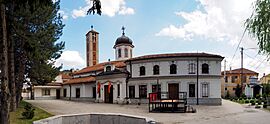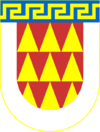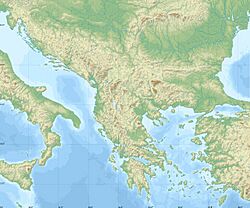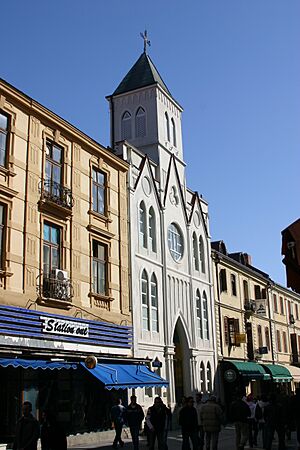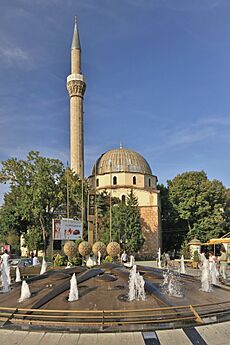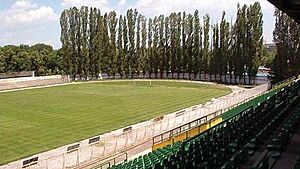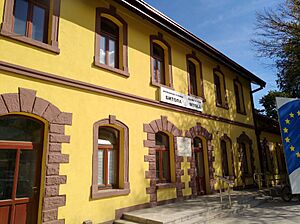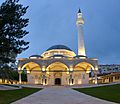Bitola facts for kids
Quick facts for kids
Bitola
Битола (Macedonian)
|
|||
|---|---|---|---|
|
Bitola
|
|||
|
|||
| Nickname(s): | |||
| Motto(s): | |||
| Country | |||
| Region | |||
| Municipality | |||
| Area | |||
| • City | 26,37 km2 (1,018 sq mi) | ||
| Elevation | 650 m (2,130 ft) | ||
| Population
(2021)
|
|||
| • City | 69,287 | ||
| • Density | 26.275/km2 (68.052/sq mi) | ||
| • Metro | |||
| Time zone | UTC+1 (CET) | ||
| • Summer (DST) | UTC+2 (CEST) | ||
| Postal codes |
7000
|
||
| Area code(s) | +389 (0)47 | ||
| Car plates | BT | ||
| Climate | Cfb | ||
Bitola (pronounced BEE-toh-lah) is a city in the southwestern part of North Macedonia. It's located in a valley called Pelagonia, surrounded by mountains like Baba and Nidže. The city is about 14 kilometers (9 miles) north of the border with Greece.
Bitola is a very important city. It connects the Adriatic Sea region with the Aegean Sea and Central Europe. It's a big center for government, culture, industry, business, and education. During the time of the Ottoman Empire, it was known as the "City of Consuls" because many European countries had their offices there.
Bitola, also called Manastır or Monastir by the Ottomans, is one of the oldest cities in North Macedonia. It was founded around 350 BC by Philip II of Macedon and was called Heraclea Lyncestis. It was even a capital city for a short time during the First Bulgarian Empire (1015–1018) and later for Ottoman Rumelia. Today, Bitola is the third-largest city in North Macedonia, after Skopje and Kumanovo. It is also the main city of the Bitola Municipality.
Contents
- What's in a Name? The Meaning of Bitola
- Where is Bitola? Exploring its Geography
- Bitola's Weather: A Look at the Climate
- Bitola's Long History
- Exploring Bitola: Main Sights
- Širok Sokak: The Wide Alley
- The Clock Tower: A Timeless Landmark
- Church of Saint Demetrius: A Hidden Gem
- Co-Cathedral of the Sacred Heart: A Catholic Landmark
- Heraclea Lyncestis: Ancient Ruins
- The Covered Bazaar: A Historic Marketplace
- Gazi Hajdar Kadi Mosque: Islamic Art
- New Mosque, Bitola: A Modern Look
- Ishak Çelebi Mosque: A Place of Peace
- The Old Bazaar: A Lively Hub
- Deboj Bath: An Ottoman Bathhouse
- Bitola Today: A Modern City
- City Council: How Bitola is Governed
- Sports in Bitola
- Getting Around: Transport in Bitola
- People of Bitola: Demographics
- Culture and Festivals in Bitola
- Manaki Festival of Film and Camera
- Ilindenski Denovi: Folk Festival
- Small Montmartre of Bitola: Children's Art
- Bitolino: Children's Theater Festival
- Si-Do: Children's Song Festival
- Interfest: Classical Music Festival
- Akto Festival: Contemporary Arts
- International Monodrama Festival
- Lokum Fest: A Sweet Cultural Event
- Learning in Bitola: Education
- People from Bitola
- Twin Towns: Bitola's Sister Cities
- Images for kids
- See also
What's in a Name? The Meaning of Bitola
The name Bitola comes from an old Slavic word meaning "monastery" or "cloister." This is because the city used to have many monasteries. The name was first written down in the Bitola inscription in 1015.
Other names for the city also mean "monastery." For example, the modern Greek name is Monastíri, and the Turkish name is Manastır. These names show how important monasteries were to the city's history.
Where is Bitola? Exploring its Geography
Bitola is in the southwestern part of North Macedonia. The Dragor River flows right through the city. Bitola sits about 615 meters (2,018 feet) above sea level, at the base of Baba Mountain.
One of its most famous spots is Pelister mountain, which is 2,601 meters (8,533 feet) high. It's a national park with amazing plants and animals, including a rare type of pine tree called Macedonian pine. Pelister is also a popular place for skiing. Bitola is a key center for industry, farming, business, education, and culture in the region.
Bitola's Weather: A Look at the Climate
Bitola has a mild continental climate. This means it has very warm and dry summers, and cold, snowy winters. It's similar to an oceanic climate in some ways.
| Climate data for Bitola (1961-1990, extremes 1948-1993) | |||||||||||||
|---|---|---|---|---|---|---|---|---|---|---|---|---|---|
| Month | Jan | Feb | Mar | Apr | May | Jun | Jul | Aug | Sep | Oct | Nov | Dec | Year |
| Record high °C (°F) | 17.2 (63.0) |
21.2 (70.2) |
31.2 (88.2) |
30.0 (86.0) |
32.5 (90.5) |
38.0 (100.4) |
40.6 (105.1) |
39.0 (102.2) |
36.0 (96.8) |
30.8 (87.4) |
26.1 (79.0) |
19.4 (66.9) |
40.6 (105.1) |
| Mean daily maximum °C (°F) | 3.3 (37.9) |
6.5 (43.7) |
11.3 (52.3) |
16.5 (61.7) |
21.7 (71.1) |
25.9 (78.6) |
28.6 (83.5) |
28.5 (83.3) |
24.8 (76.6) |
18.3 (64.9) |
11.5 (52.7) |
5.3 (41.5) |
16.9 (62.4) |
| Daily mean °C (°F) | −0.8 (30.6) |
1.9 (35.4) |
6.3 (43.3) |
11.1 (52.0) |
15.7 (60.3) |
19.5 (67.1) |
21.7 (71.1) |
21.1 (70.0) |
17.2 (63.0) |
11.4 (52.5) |
6.2 (43.2) |
1.0 (33.8) |
11.0 (51.8) |
| Mean daily minimum °C (°F) | −4.5 (23.9) |
−2.3 (27.9) |
1.3 (34.3) |
5.0 (41.0) |
8.7 (47.7) |
11.7 (53.1) |
13.1 (55.6) |
12.8 (55.0) |
9.9 (49.8) |
5.6 (42.1) |
1.7 (35.1) |
−2.6 (27.3) |
5.0 (41.0) |
| Record low °C (°F) | −29.4 (−20.9) |
−26.1 (−15.0) |
−18.7 (−1.7) |
−3.5 (25.7) |
−1.6 (29.1) |
3.3 (37.9) |
5.4 (41.7) |
2.6 (36.7) |
−1.0 (30.2) |
−6.1 (21.0) |
−15.3 (4.5) |
−26.7 (−16.1) |
−29.4 (−20.9) |
| Average precipitation mm (inches) | 50.1 (1.97) |
49.9 (1.96) |
51.2 (2.02) |
43.8 (1.72) |
61.0 (2.40) |
40.4 (1.59) |
40.2 (1.58) |
31.2 (1.23) |
35.0 (1.38) |
55.9 (2.20) |
73.2 (2.88) |
68.0 (2.68) |
599.9 (23.62) |
| Average precipitation days (≥ 1.0 mm) | 8 | 8 | 8 | 7 | 8 | 6 | 5 | 4 | 5 | 6 | 8 | 9 | 82 |
| Average relative humidity (%) | 83 | 78 | 71 | 65 | 65 | 60 | 56 | 57 | 64 | 72 | 79 | 83 | 69 |
| Mean monthly sunshine hours | 81.1 | 106.9 | 155.2 | 199.2 | 250.5 | 291.3 | 334.0 | 312.2 | 241.0 | 176.5 | 111.1 | 75.9 | 2,334.9 |
| Source 1: NOAA | |||||||||||||
| Source 2: Deutscher Wetterdienst (extremes) | |||||||||||||
Bitola's Long History
Bitola has a very long and interesting history, going back thousands of years.
Early Settlements: Prehistory in Bitola
Archaeologists have found signs of human settlements around Bitola from as early as 6000 BC. These early villages, called tells, show that people lived here a very long time ago.
Ancient Times: Heraclea Lyncestis
The ancient city of Heraclea Lyncestis was founded by Philip II of Macedon in the 4th century BC. It was named after the Greek hero Heracles. This city was very important because of its location. When the Romans took over in 148 BC, Heraclea continued to be a rich city, mainly because the important Via Egnatia road passed nearby.
Today, you can still see ruins from the Roman period in Heraclea, like a portico (a covered walkway), thermae (baths), and a theater that could hold about 2,500 people.
Byzantine Era: A Center of Faith
In the early Byzantine Empire (4th to 6th centuries AD), Heraclea became an important center for bishops. The city had strong walls, many early Christian churches (called basilicas), and a bishop's home. The floors of the Great Basilica are covered with beautiful mosaics showing plants and figures. These mosaics are considered some of the best early Christian art in the region.
However, in the late 6th century, different tribes attacked the city. The grand buildings fell apart, and Heraclea slowly became a small settlement.
Middle Ages: A City of Monasteries
In the 6th and 7th centuries, many Slavic tribes settled around Bitola. They built houses and a fortress. Bitola was part of the First Bulgarian Empire from the 8th to the 11th centuries, and then part of the Byzantine Empire again. For a short time in the 14th century, it was part of the Serbian Empire. Many monasteries and churches were built during this time, which is why the city was also called Manastir (meaning "monastery").
In the 10th century, tsar Samuel of Bulgaria ruled Bitola and built a castle. In 1015, Tsar Gavril Radomir was killed by his cousin Ivan Vladislav, who then rebuilt the city's fortress. To remember this, a stone inscription was placed in the fortress, which is where the Slavic name "Bitol" (Bitola) is first mentioned.
Before the Ottomans arrived in the mid-14th century, Bitola was a very important center for military, politics, and religion. It had strong trade connections across the Balkan Peninsula.
Ottoman Rule: The City of Consuls
From 1382 to 1912, Bitola was part of the Ottoman Empire and was known as Monastir. After some wars, the city's trade slowed down. But by the late 19th century, it became the second-largest city in the southern Balkan region, after Thessaloniki.
Between 1815 and 1822, an Albanian leader named Ali Pasha of Yanina ruled the town. In 1874, Monastir became the main city of a large Ottoman province called Monastir Vilayet.
Bitola was famous as "the city of the consuls" because many countries had their consulates (offices for their representatives) there. In the late Ottoman period, twelve countries had consulates in Bitola. The city also had many good schools, including a military academy that was attended by Mustafa Kemal Atatürk, who later became the founder of modern Turkey.
In 1894, a train line connected Monastir with Thessaloniki. The first movie ever made in the Balkans was filmed in Monastir in 1903 by the Manakis brothers. Today, the annual Manaki Brothers International Cinematographers Film Festival is held in Bitola to honor them.
In 1908, the Congress of Manastir was held in the city. This important meeting standardized the modern Albanian alphabet.
Ilinden Uprising: A Fight for Freedom
The Bitola region was a key area during the Ilinden-Preobrazhenie Uprising in 1903. This uprising was organized by the Internal Macedonian Revolutionary Organization (IMRO) to fight against Ottoman rule. Many battles took place in villages around Bitola, but the rebels were eventually defeated.
Balkan Wars and World War I
In 1912, several Balkan countries fought against the Ottomans in the First Balkan War. Serbian troops took control of Bitola. After the war, in 1913, the region of Macedonia was divided, and Monastir became part of Serbia, officially changing its name to Bitola.
During World War I, Bitola was on the Salonica front. Bulgarian forces took the city in 1915, but the Allied forces recaptured it in 1916. Bitola became a front-line city and was heavily bombed almost every day, causing a lot of destruction.
Modern Times: After the Wars
After World War I, Bitola became part of the Kingdom of Serbs, Croats and Slovenes, which was later renamed Yugoslavia. During World War II, German and Bulgarian forces occupied the city. However, in September 1944, Bulgaria changed sides, and on November 4, the 7th Macedonian Liberation Brigade entered Bitola after the Germans left.
The city had a historic Jewish community of Sephardic origin. Sadly, on March 11, 1943, most of the Jewish population (3,276 people) were sent to the Treblinka extermination camp. After the war, Bitola became part of the new PR Macedonia within Yugoslavia.
In 1945, the first high school to use the Macedonian language was opened in Bitola.
Exploring Bitola: Main Sights
Bitola has many beautiful and historic buildings from different time periods, especially from the Ottoman era.
Širok Sokak: The Wide Alley
Širok Sokak (meaning "Wide Alley") is a long pedestrian street in Bitola. It's a popular place for walking, shopping, and enjoying the city atmosphere.
The Clock Tower: A Timeless Landmark
No one knows exactly when Bitola's clock tower was built. Some records from the 16th century mention a clock tower, but it might not be the same one we see today. Many believe it was built around 1830, at the same time as the St. Dimitrija Church.
The tower is about 30 meters (98 feet) tall and has a rectangular base. The original clock was replaced during World War II with a new one given by the Nazis.
Church of Saint Demetrius: A Hidden Gem
The Church of Saint Demetrius was built in 1830. From the outside, it looks simple, as churches during the Ottoman Empire had to be. But inside, it is richly decorated with beautiful chandeliers, a carved bishop's throne, and an amazing iconostasis (a screen covered with icons).
The most striking part is the arch above the imperial quarters, which has figures of Jesus and the apostles. The church also has many old icons and frescoes, some dating back to the 19th century.
Co-Cathedral of the Sacred Heart: A Catholic Landmark
Bitola also has the Co-Cathedral of the Sacred Heart, which is an important church for the Catholic community in the city.
Heraclea Lyncestis: Ancient Ruins
Heraclea Lyncestis (pronounced He-RAK-lee-ah Link-ES-tis) was a major ancient city. Its ruins are located in the southern part of Bitola, about 2 kilometers (1.2 miles) from the city center. You can explore the remains of this city founded by Philip II of Macedon.
The Covered Bazaar: A Historic Marketplace
The covered bedisten (bazaar) is one of the most impressive and oldest buildings in Bitola from the Ottoman period. It looks like a fortress with many domes and inner streets. It was built in the 15th century and used to sell textiles and luxury fabrics. It was also a treasury where money from the region was kept. Today, it still has many shops selling different products.
Gazi Hajdar Kadi Mosque: Islamic Art
The Gazi Hajdar Kadi Mosque is a beautiful example of Islamic architecture in Bitola. It was built in the 1560s. After being damaged and used for storage, it has been restored to its original look.
New Mosque, Bitola: A Modern Look
The New Mosque is in the city center. It has a square base and a dome, with a 40-meter (131-foot) tall minaret. Today, the mosque's rooms are used for art exhibitions. Recent digs show it was built on top of an old church.
Ishak Çelebi Mosque: A Place of Peace
The Ishak Çelebi Mosque is another important mosque in Bitola. Its large yard contains several tombs with interesting sarcophagi (stone coffins).
The Old Bazaar: A Lively Hub
The old bazaar (called Stara Čaršija in Macedonian) has been mentioned in city descriptions since the 16th century. It's a bustling area where people still buy and sell goods today.
Deboj Bath: An Ottoman Bathhouse
The Deboj Bath is an Ottoman Empire-era hamam (bathhouse). It was once damaged but has been repaired and now looks like its original design with two large domes.
Bitola Today: A Modern City
Bitola is a key economic and industrial center in southwestern North Macedonia. Many large companies are based here, including the Pelagonia agricultural company, which is the country's biggest food producer. The Streževo water system is also the largest in North Macedonia. The three power stations of REK Bitola produce almost 80% of the country's electricity.
Bitola is known as "the city of consuls" because it hosts thirteen consulates from different countries.
- General Consulates
- Honorary Consulates
 Albania (since 2019)
Albania (since 2019) Austria (since 2014)
Austria (since 2014) Bosnia and Herzegovina (since 2014)
Bosnia and Herzegovina (since 2014) France (since 1996)
France (since 1996) Hungary (since 2012)
Hungary (since 2012) Montenegro (since 2008)
Montenegro (since 2008) Romania (since 2007)
Romania (since 2007) Serbia (since 2007)
Serbia (since 2007) Turkey (since 1998)
Turkey (since 1998) Ukraine (since 2011)
Ukraine (since 2011)
Media in Bitola
Bitola has one television station, Tera, and a few local radio stations like Radio 105 (Bombarder) and UKLO FM. There is also a local weekly newspaper called Bitolski Vesnik.
City Council: How Bitola is Governed
The Bitola Municipality Council is the group that governs the city and municipality of Bitola. They approve or reject projects proposed by its members and the Mayor. The Council members are elected for four-year terms. Currently, there are 31 councillors.
The Council has different committees that focus on specific areas:
- Finance and Budget Committee
- Commission for Public Utilities
- Committee on Urban Planning, public works and environmental protection
- Commission for social activities
- Commission for local government
- Commission to mark holidays, events and award certificates and awards
Sports in Bitola
The most popular sports in Bitola are football (soccer) and handball.
The main football team is FK Pelister. They play at the Petar Miloševski Stadium. Many famous footballers from Bitola, like Georgi Hristov and Toni Savevski, started their careers with this club.
Bitola's main handball club is RK Eurofarm Pelister, which is also the city's most famous sports team. Both this team and RK Eurofarm Pelister 2 play their games at the Sports Hall Boro Čurlevski.
The main basketball club is KK Pelister, and they also play at the Sports Hall Boro Čurlevski. All sports teams named Pelister are supported by their dedicated fans, known as Čkembari.
Getting Around: Transport in Bitola
The city has the Bitola railway station, which offers train services as far north as Belgrade.
People of Bitola: Demographics
Bitola has always been a city with many different groups of people. In the late 19th century, it had about 37,500 residents, including Aromanians, Muslims (Turks, Roma, and Albanians), and a Jewish community. Slavic-speaking people were also present.
According to the 2021 census, the city of Bitola has 69,287 inhabitants. The main ethnic group is Macedonians. There are also significant numbers of Romani, Albanians, Turks, Aromanians, and Serbs.
- Ethnic groups (2021)
| Ethnic group |
census 1948 | census 1953 | census 1961 | census 1971 | census 1981 | census 1994 | census 2002 | census 2021 | ||||||||
|---|---|---|---|---|---|---|---|---|---|---|---|---|---|---|---|---|
| Number | % | Number | % | Number | % | Number | % | Number | % | Number | % | Number | % | Number | % | |
| Macedonians | 23,734 | 77.2 | 28,912 | 77.0 | 43,108 | 88.0 | 57,282 | 88.1 | 68,897 | 87.8 | 70,528 | 91.0 | 66,038 | 88.6 | 55,995 | 80.8 |
| Romani | .. | .. | 3 | 0.0 | .. | .. | 28 | 0.0 | 535 | 0.7 | 1,676 | 2.2 | 2,577 | 3.5 | 2,862 | 4.1 |
| Albanians | 1,327 | 4.3 | 484 | 1.3 | 378 | 0.8 | 1,317 | 2.0 | 2,347 | 3.0 | 1,967 | 2.5 | 2,360 | 3.2 | 2,441 | 3.5 |
| Turks | 3,543 | 11.5 | 6,189 | 16.5 | 3,265 | 6.7 | 3,061 | 4.7 | 3,068 | 3.9 | 1,547 | 2.0 | 1,562 | 2.1 | 1,115 | 1.6 |
| Aromanians | 420 | 1.4 | 482 | 1.3 | .. | .. | .. | .. | 543 | 0.7 | 696 | 0.9 | 997 | 1.3 | 1,003 | 1.4 |
| Serbs | 912 | 3.0 | 834 | 2.2 | 1,035 | 2.1 | 1,143 | 1.8 | 843 | 1.1 | 556 | 0.7 | 499 | 0.7 | 321 | 0.5 |
| Bosniaks | 0 | 0.0 | 0 | 0.0 | 0 | 0.0 | 0 | 0.0 | 0 | 0.0 | 0 | 0.0 | 20 | 0.3 | 0.0 | 0.1 |
| Others | 825 | 2.7 | 660 | 1.8 | 1,215 | 2.5 | 2,204 | 3.4 | 2,274 | 2.9 | 494 | 0.6 | 497 | 0.7 | 729 | 1.1 |
| PWDTFAS* | 4,774 | 6.9 | ||||||||||||||
| Total | 30,761 | 37,564 | 49,001 | 65,035 | 78,507 | 77,464 | 74,550 | 69,287 | ||||||||
- PWDTFAS-Persons for whom data are taken
Languages Spoken in Bitola
The most common language spoken in Bitola is Macedonian. Other languages spoken include Albanian, Turkish, Aromanian, and Serbian.
| Languages | ||||
|---|---|---|---|---|
| Macedonian | 92.9% | |||
| Albanian | 3.2% | |||
| Turkish | 1.9% | |||
| Aromanian | 0.7% | |||
| Serbian | 0.5% | |||
| Romani | 0.4% | |||
| Bosnian | 0.01% | |||
| Others | 0.4% | |||
| Language | Total number | % from total population |
|---|---|---|
| Macedonian | 69.255 | 92.9 |
| Albanian | 2.399 | 3.2 |
| Turkish | 1.392 | 1.9 |
| Aromanian | 548 | 0.7 |
| Serbian | 390 | 0.5 |
| Romani | 287 | 0.4 |
| Bosnian | 10 | 0.01 |
| Others | 269 | 0.4 |
Religion in Bitola
Bitola is an important religious center and the seat of the Diocese of Prespa-Pelagonia for the Macedonian Orthodox Church. This diocese covers Bitola and several other cities. It has about 500 churches and monasteries. Many new churches and church buildings have been built or are being built in recent years.
Besides the main Macedonian Orthodox Church, Bitola also has other religious groups, including the Islamic community and the Roman Catholic Church.
| Religion | ||||
|---|---|---|---|---|
| Orthodox | 89.2% | |||
| Islam | 9.2% | |||
| Catholicism | 0.2% | |||
| Protestantism | 0.01% | |||
| Others | 1.4% | |||
| Religion | Total number | % from total population |
|---|---|---|
| Orthodox | 66.492 | 89.2 |
| Muslims | 6.843 | 9.2 |
| Catholics | 140 | 0.2 |
| Protestants | 9 | 0.01 |
| Others | 1.066 | 1.4 |
- Bitola's Cathedral of the Sacred Heart of Jesus is the co-cathedral of the Roman Catholic Diocese of Skopje.
Culture and Festivals in Bitola
Bitola is part of the UNESCO Creative Cities Network, recognized for its rich culture.
Manaki Festival of Film and Camera
This festival is held every September to honor Milton Manaki, one of the first cameramen in the Balkans. It shows both documentary and full-length films. Many famous actors have attended this world-class event.
Ilindenski Denovi: Folk Festival
Every year, Bitola hosts the "Ilinden Days" folk festival. This 4-5 day event features music, songs, and dances. It celebrates the Ilinden Uprising and focuses on the folk culture of North Macedonia. Many folklore groups participate.
Small Montmartre of Bitola: Children's Art
The "Small Montmartre of Bitola" is a successful children's art festival. Children from all over the world come to create art. Their artworks are displayed in North Macedonia and around the world. This festival has won many awards.
Bitolino: Children's Theater Festival
Bitolino is an annual children's theater festival held in August. Professional children's theaters from around the world take part. The best performance wins a grand prize.
Si-Do: Children's Song Festival
Every May, Bitola hosts the international children's song festival Si-Do. Children from across Europe participate, singing about 20 songs. Many Macedonian musicians, like Next Time and Karolina Goceva, have been part of this festival.
Interfest: Classical Music Festival
Interfest is an international festival mainly for classical music. Musicians from all over the world perform classical pieces. The festival also includes pop music nights, theater plays, art exhibitions, and literature presentations. Bitola is known for having many pianos, so one night is dedicated to piano competitions.
Akto Festival: Contemporary Arts
The Akto Festival for Contemporary Arts is a regional festival that started in 2006. It includes visual arts, performing arts, music, and cultural discussions. The festival aims to explore and redefine modern society's cultural ideas. Artists from many countries have participated.
International Monodrama Festival
This annual festival of monodrama (plays with one actor) is held in April. Actors from around the world come to Bitola to perform.
Lokum Fest: A Sweet Cultural Event
Lokum Fest is a cultural and tourist event that began in 2007. It takes place every July in Bitola's old Turkish bazaar. It's part of the Bitola Cultural Summer festival.
Learning in Bitola: Education
St. Clement of Ohrid University of Bitola was founded in 1979. It was created to meet the need for skilled professionals outside the capital city. Since 1994, it has been named after the Slavic educator St. Clement of Ohrid. The university has different departments in Bitola, Ohrid, and Prilep. It works with other universities in the Balkans and Europe.
The university includes these faculties and institutes:
- Technical Faculty – Bitola
- Economical Faculty – Prilep
- Faculty of Tourism and Leisure management – Ohrid
- Teachers Faculty – Bitola
- Faculty of biotechnological sciences – Bitola
- Faculty of Information and Communication Technologies — Bitola
- Medical college – Bitola
- Faculty of Veterinary Sciences – Bitola
- Tobacco institute – Prilep
- Hydro-biological institute – Ohrid
- Slavic cultural institute – Prilep
Bitola has seven high schools:
- "Josip Broz-Tito" (a general high school)
- "Taki Daskalo" (another general high school, including mining survey)
- "Dr. Jovan Kalauzi" (a medical high school)
- "Jane Sandanski" (an economical high school)
- "Gjorgji Naumov" (a technological high school)
- "Kuzman Šapkarev" (an agricultural high school)
- "Toše Proeski" (a musical high school)
There are also ten primary schools in Bitola:
- "Todor Angelevski"
- "Sv. Kliment Ohridski"
- "Goce Delčev"
- "Elpida Karamandi"
- "Dame Gruev"
- "Kiril i Metodij"
- "Kole Kaninski"
- "Trifun Panovski"
- "Stiv Naumov"
- "Gjorgji Sugarev"
People from Bitola
Twin Towns: Bitola's Sister Cities
Bitola is twinned with many cities around the world, meaning they have a special friendship and cultural exchange.
 Épinal, France, since 1976
Épinal, France, since 1976 Kranj, Slovenia, since 1976
Kranj, Slovenia, since 1976 Požarevac, Serbia, since 1976
Požarevac, Serbia, since 1976 Trelleborg, Sweden, since 1981
Trelleborg, Sweden, since 1981 Rockdale, Australia, since 1985
Rockdale, Australia, since 1985 Bursa, Turkey, since 1995
Bursa, Turkey, since 1995 Esztergom, Hungary, since 1998
Esztergom, Hungary, since 1998 Pleven, Bulgaria, since 1999
Pleven, Bulgaria, since 1999 Pushkin, Russia, since 2005
Pushkin, Russia, since 2005 Kremenchuk, Ukraine, since 2006
Kremenchuk, Ukraine, since 2006 Stari Grad (Belgrade), Serbia, since 2006
Stari Grad (Belgrade), Serbia, since 2006 Veliko Tarnovo, Bulgaria, since 2006
Veliko Tarnovo, Bulgaria, since 2006 Nizhny Novgorod, Russia, since 2008
Nizhny Novgorod, Russia, since 2008 Rijeka, Croatia, since 2011
Rijeka, Croatia, since 2011 Ningbo, China, since 2014
Ningbo, China, since 2014 Cetinje, Montenegro, since 2020
Cetinje, Montenegro, since 2020
Images for kids
-
St. Demetrius Church, Cathedral church of Prespa-Pelagonium Eparchy
-
Orthodox St. Bogorodica church
-
The Jewish cemetery
-
A monument of Philip II of Macedon
See also
 In Spanish: Bitola para niños
In Spanish: Bitola para niños









